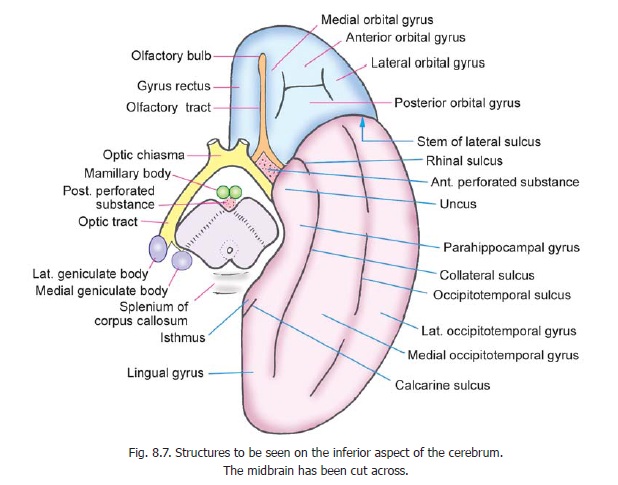Chapter: Human Neuroanatomy(Fundamental and Clinical): Internal Structure of the Spinal Cord
Preliminary Review of the Brainstem

Preliminary Review of the Brainstem
The brainstem consists (from above downwards) of the midbrain, the pons and the medulla (Figs 6.1, 6.2). The midbrain is continuous, above, with the cerebral hemispheres. The medulla is continuous, below, with the spinal cord. Posteriorly, the pons and medulla are separated from the cerebellum by the fourth ventricle (Fig. 6.3). The ventricle is continuous, below, with the central canal, which traverses the lower part of the medulla, and becomes continuous with the central canal of the spinal cord. Cranially, the fourth ventricle is continuous with the aqueduct, which passes through the midbrain. The midbrain, pons and medulla are connected to the cerebellum by the superior, middle and inferior cerebellar peduncles, respectively.

A number of cranial nerves are attached to the brainstem. The third and fourth nerves emerge from the surface of the midbrain; and the fifth from the pons. The sixth, seventh and eighth nerves emerge at the junction of the pons and medulla. The ninth, tenth, eleventh and twelfth cranial nerves emerge from the surface of the medulla.
The surface of the brainstem is intimately related to the meninges and to arteries and veins.


The Medulla: gross anatomy
The medulla is broad above, where it joins the pons; and narrows down below, where it becomes continuous with the spinal cord. Its length is about 3 cm and its width is about 2 cm at its upper end.
The junction of the medulla and cord is usually described as lying at the level of the upper border of the atlas vertebra. The transition is, in fact, not abrupt but occurs over a certain distance. The medulla is divided into a lower closed part, which surrounds the central canal; and an upper open part, which is related to the lower part of the fourth ventricle. The surface of the medulla is marked by a series of fissures or sulci that divide it into a number of regions. The anterior median fissure and the posterior median sulcus are upward continuations of the corresponding features seen on the spinal cord. On each side the anterolateral sulcus lies in line with the ventral roots of spinal nerves. The rootlets of the hypoglossal nerve emerge from this sulcus. The posterolateral sulcuslies in line with the dorsal nerve roots of spinal nerves, and gives attachment to rootlets of the glossopharyngeal, vagus and accessory nerves. The region between the anterior median sulcus and the anterolateral sulcus is occupied (on either side of the midline) by an elevation called the pyramid. The elevation is caused by a large bundle of fibres that descend from the cerebral cortex to the spinal cord. Some of these fibres cross from one side to the other in the lower part of the medulla, obliterating the anterior median fissure. These crossing fibres constitute the decussation of the pyramids.
Some other fibres emerge from the anterior median fissure, above the decussation, and wind laterally over the surface of the medulla. These are the anterior external arcuate fibres. In the upper part of the medulla, the region between the anterolateral and posterolateral sulci shows a prominent, elongated, oval swelling named the olive. This swelling is about half an inch long. It is produced by a large mass of grey matter called the inferior olivary nucleus. The posterior part of the medulla, between the posterior median sulcus and the posterolateral sulcus, contains tracts that enter it from the posterior funiculus of the spinal cord. These are thefasciculus gracilis lying medially, next to the midline, and the fasciculus cuneatus lying laterally. These fasciculi end in rounded elevations called the gracile and cuneate tubercles. These tubercles are produced by masses of grey matter called the nucleus gracilisand the nucleus cuneatus respectively. Just above these tubercles the posterior aspect of the medulla is occupied by a triangular fossa which forms the lower part of the floor of the fourth ventricle. This fossa is bounded on either side by the inferior cerebellar peduncle. The lower part of the medulla, immediately lateral to the fasciculus cuneatus, is marked by another longitudinal elevation called the tuberculum cinereum. This elevation is produced by an underlying collection of grey matter called the spinal nucleus of the trigeminal nerve. The grey matter of this nucleus is covered by a layer of nerve fibres that form the spinal tract of the trigeminalnerve.
The Pons: gross anatomy
The pons shows a convex anterior surface, marked by prominent transversely running fibres. Laterally, these fibres collect to form a bundle, the middle cerebellar peduncle. The trigeminal nerve emerges from the anterior surface, and the point of its emergence is taken as a landmark to define the plane of junction between the pons and the middle cerebellar peduncle. The anterior surface of the pons is marked, in the midline, by a shallow groove, the sulcus basilaris, which lodges the basilar artery. The line of junction between the pons and the medulla is marked by a groove through which a number of cranial nerves emerge. The abducent nerve emerges from just above the pyramid and runs upwards in close relation to the anterior surface of the pons. The facial and vestibulo-cochlear nerves emerge from the interval between the olive and the pons. The posterior aspect of the pons forms the upper part of the floor of the fourth ventricle.
On either side of the lower part of the pons there is a region called the cerebello-pontine angle. This region lies near the lateral aperture of the fourth ventricle. The facial, vestibulo-cochlear and glossopharyngeal nerves, the nervus intermedius, and sometimes the labyrinthine arteries lie in this region.
The Midbrain: gross anatomy
When the midbrain is viewed from the anterior aspect, we see two large bundles of fibres, one on each side of the middle line. These are the crura of the midbrain. The crura are separated by a deep fissure. Near the pons the fissure is narrow, but broadens as the crura diverge to enter the corresponding cerebral hemispheres. The parts of the crura just below the cerebrum form the posterior boundary of a space called the interpeduncular fossa (Fig. 8.7). The oculomotor nerve emerges from the medial aspect of the crus (singular of crura) of the same side.

The posterior aspect of the midbrain is marked by four rounded swellings. These are the colliculi, one superior and one inferior on each side. Each colliculus is related laterally to a ridge called the brachium. The superior brachium (also called the superior quadrigeminal brachium, or brachiumof superior colliculus) connects the superior colliculus to the lateral geniculate body. Similarly, the inferior brachium (also called the inferior quadrigeminal brachium or brachium of inferior colliculus)connects the inferior colliculus to the medial geniculate body. Just below the colliculi, there is the uppermost part of a membrane, the superior medullary velum, which stretches between the two superior cerebellar peduncles, and helps to form the roof of the fourth ventricle. The trochlear nerve emerges from the velum, and then winds round the side of the midbrain to reach its ventral aspect.
In the description of the surface features of the brainstem, given above, reference has been made to the floor of the fourth ventricle.
Related Topics